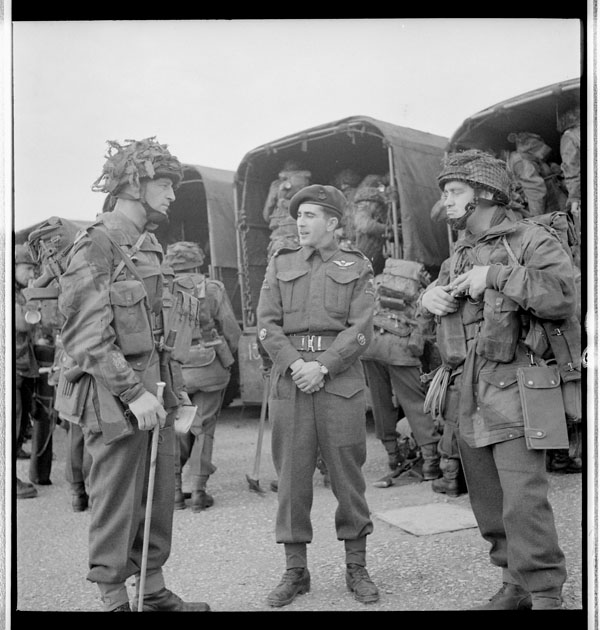Colby Cosh reminds us that Canadian troops landed in Normandy in at least one other location than on Juno Beach:

From left to right, Regimental Sergeant-Major “Knobby” Clark, Company Sergeant-Major Norbert Joseph and Company Sergeant-Major Outhwaite of the 1st Canadian Parachute Battalion getting ready to leave Carter Barracks for their D-Day transit camp, May 1944.
Canada. Dept. of National Defence / Library and Archives Canada / e002852749
Col. C.P. Stacey’s 1946 history of 1st Canadian Parachute Battalion in Normandy describes the expectations of high command chillingly. For the purposes of the invasion, the Canadians operated as a component of the British 6th Airborne Division, assigned to blow up bridges, seize crossroads and establish advance observation posts deep in enemy territory. The War Office estimated, Stacey wrote, “that the wastage for the first month would be at the double intense rate, i.e., 50 per cent of War Establishment for officers and 40 per cent for other ranks.”
With regard to the Canadian airborne, this accounting proved largely accurate: 541 men from the battalion left England to be dropped into the battle of Normandy, the enumerated casualties for June 6 alone were two “presumed killed,” 18 dead, six wounded, and 81 taken prisoner. The unit lost no more to capture after the first day, but by June 17, when the battalion was removed from the front line for the first time, the other categories had swelled to 48 killed and 113 wounded. Stacey’s calculation of the actual “wastage” rate is that it was 59 per cent for officers and 39 per cent for other ranks.
If you have read about the paras, it is perhaps not the casualty figures that strike you so much as the unique Gothic horror of their particular experience of D-Day. The Americans’ use of parachute attacks in Sicily had taught planners that putting soldiers right on the intended drop zone never went as well as in training. Pilots who were comfortable flying slow and at suitable height over Fort Benning inevitably found themselves less cool over enemy terrain dotted with anti-aircraft guns and small arms.
In some cases evasive manoeuvres flung the airborne infantry out of the hatch without warning. Meanwhile, flat areas that had looked like green fields in photos turned out to be algae-covered swamps, some intentionally flooded by the Germans. Anyone who had volunteered for the paratroops in the hope of avoiding drowning could be in for a dreadful surprise. The historian Dan Hartigan, son of a 1st Battalion vet of the same name, describes a close shave for Sgt. W.R. Kelly, later killed in the Battle of the Bulge. “One man found Sergeant Kelly hanging upside down with his head in the water, from a huge deadwood tree. … The canopy had caught on a limb and suspended Kelly so he was submerged from the top of his head to his neck.” Kelly was rescued by a nearby comrade, but some soldiers in similar predicaments dropped alone and were not so lucky. In darkness and confusion, others landed badly, broke limbs, and were out of action at once.



